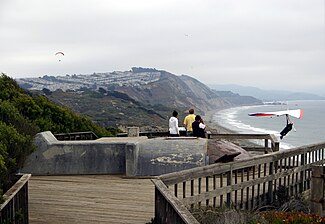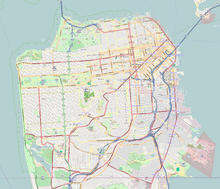Fort Funston
| Fort Funston | |
|---|---|

A hang glider launches from Fort Funston Overlook, San Francisco. The launch platform is modified from a former fire control bunker.
|
|
| Location | San Francisco, California, United States |
| Coordinates | 37°42′54″N 122°30′07″W / 37.714958°N 122.501915°WCoordinates: 37°42′54″N 122°30′07″W / 37.714958°N 122.501915°W |
| Operated by | Golden Gate National Parks Conservancy |
| Official website | |
Fort Funston is a former harbor defense installation located in the southwestern corner of San Francisco. Formerly known as the Lake Merced Military Reservation, the fort is now a protected area within the Golden Gate National Recreation Area (GGNRA). It was named in honor of Frederick N. Funston (1865–1917), a Major General in the United States Army with strong connections to San Francisco, and included several artillery batteries. The fort is located on Skyline Boulevard at John Muir Drive, west of Lake Merced.
The Fort was constructed upon windswept headlands along the Pacific coast and Ocean Beach below, above steep sandstone cliffs that provide a nesting habitat for a colony of bank swallows (Riparia riparia). The last remnants of a sand dune ecosystem that once covered the western half of San Francisco grows along the top of the headlands, with trailheads forming part of the California Coastal Trail that runs through San Francisco County.
The land was acquired by the federal government in 1900 as the Lake Merced Military Reservation, originally intended to accommodate two 12-inch coast defense mortar batteries in the Coast Defenses of San Francisco (later Harbor Defenses). However, nothing significant was built there until after the American entry into World War I in early 1917. The fort, renamed for Major General Frederick Funston shortly after his death in 1917, began to take shape during World War I, with the construction of a parade ground, barracks and a series of coastal batteries. These were Battery Howe with four 12-inch mortars and Battery Bruff with two 5-inch M1900 guns on pedestal mounts. These weapons were relocated from Batteries McKinnon and Sherwood at Fort Winfield Scott, adjacent to the Presidio. Battery Howe was named for Walter Howe, a general and veteran of the Indian wars who died in 1915. Battery Bruff was named after Lawrence Bruff, an Ordnance Corps colonel and instructor at West Point who died in 1911. In 1920 Battery Bruff was disarmed due to a withdrawal from Army service of the 5-inch gun. In the early 1920s, Anti-aircraft Battery No. 5 of three 3-inch guns was built at the fort.
...
Wikipedia

